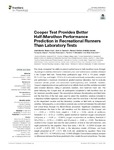Mostrar o rexistro simple do ítem
Cooper Test Provides Better Half-Marathon Performance Prediction in Recreational Runners than Laboratory Test
| dc.contributor.advisor | ||
| dc.contributor.author | Alvero Cruz, José Ramón | |
| dc.contributor.author | Carnero, Elvis | |
| dc.contributor.author | Giráldez-García, Manuel Avelino | |
| dc.contributor.author | Alacid, Fernando | |
| dc.contributor.author | Rosemann, Thomas | |
| dc.contributor.author | Nikolaidis, Pantelis | |
| dc.contributor.author | Knechtle, Beat | |
| dc.date.accessioned | 2019-12-04T17:44:47Z | |
| dc.date.available | 2019-12-04T17:44:47Z | |
| dc.date.issued | 2019-11-05 | |
| dc.identifier.citation | Alvero-Cruz JR, Carnero EA, Giráldez García MA, Alacid F, Rosemann T, Nikolaidis PT and Knechtle B (2019) Cooper Test Provides Better Half-Marathon Performance Prediction in Recreational Runners Than Laboratory Tests. Front. Physiol. 10:1349. doi: 10.3389/fphys.2019.01349 | es_ES |
| dc.identifier.issn | 1664042X | |
| dc.identifier.uri | http://hdl.handle.net/2183/24437 | |
| dc.description.abstract | [Abstract]: This study compared the ability to predict performance in half-marathon races through physiological variables obtained in a laboratory test and performance variables obtained in the Cooper field test. Twenty-three participants (age: 41.6 7.6 years, weight: 70.4 8.1 kg, and height: 172.5 6.3 cm) underwent body composition assessment and performed a maximum incremental graded exercise laboratory test to evaluate maximum aerobic power and associated cardiorespiratory and metabolic variables. Cooper’s original protocol was performed on an athletic track and the variables recorded were covered distance, rating of perceived exertion, and maximum heart rate. The week following the Cooper test, all participants completed a half-marathon race at the maximum possible speed. The associations between the laboratory and field tests and the final time of the test were used to select the predictive variables included in a stepwise multiple regression analysis, which used the race time in the half marathon as the dependent variable and the laboratory variables or field tests as independent variables. Subsequently, a concordance analysis was carried out between the estimated and actual times through the Bland-Altman procedure. Significant correlations were found between the time in the half marathon and the distance in the Cooper test (r = -0.93; p < 0.001), body weight (r = 0.40; p < 0.04), velocity at ventilatory threshold 1, (r = -0.72; p < 0.0001), speed reached at maximum oxygen consumption (vVO2max), (r = -0.84; p < 0.0001), oxygen consumption at ventilatory threshold 2 (VO2VT2) (r = -0.79; p < 0.0001), and VO2max (r = -0.64; p < 0.05). The distance covered in the Cooper test was the best predictor of time in the half-marathon, and might predicted by the equation: Race time (min) = 201.26 – 0.03433 (Cooper test in m) (R2 = 0.873, SEE: 3.78 min). In the laboratory model, vVO2max, and body weight presented an R2 = 0.77, SEE 5.28 min. predicted by equation: Race time (min) = 156.7177 – 4.7194 (vVO2max) – 0.3435 (Weight). Concordance analysis showed no differences between the times predicted in the models the and actual times. The data indicated a high predictive power of half marathon race time both from the distance in the Cooper test and vVO2max in the laboratory. However, the variable associated with the Cooper test had better predictive ability than the treadmill test variables. Finally, it is important to note that these data may only be extrapolated to recreational male runners. | es_ES |
| dc.language.iso | eng | es_ES |
| dc.publisher | Frontiers Media S.A. | es_ES |
| dc.relation.isreferencedby | Scopus | |
| dc.relation.uri | https://doi.org/10.3389/fphys.2019.01349 | es_ES |
| dc.rights | Atribución 3.0 España | es_ES |
| dc.rights.uri | http://creativecommons.org/licenses/by/3.0/es/ | * |
| dc.subject | Prediction equations | es_ES |
| dc.subject | Comparison performance methods | es_ES |
| dc.subject | Long-distance runners | es_ES |
| dc.subject | Field test | es_ES |
| dc.subject | Laboratory test | es_ES |
| dc.subject | Ecuaciones de predicción | es_ES |
| dc.subject | Métodos de comparación de rendimiento | es_ES |
| dc.subject | Corredores de larga distancia | es_ES |
| dc.subject | Prueba de campo | es_ES |
| dc.subject | Prueba de laboratorio | es_ES |
| dc.title | Cooper Test Provides Better Half-Marathon Performance Prediction in Recreational Runners than Laboratory Test | es_ES |
| dc.type | info:eu-repo/semantics/article | es_ES |
| dc.rights.access | info:eu-repo/semantics/openAccess | es_ES |
| UDC.journalTitle | Frontiers in Physiology | es_ES |
| UDC.volume | 10 | es_ES |
| UDC.issue | 1349 | es_ES |
| UDC.startPage | 1 | es_ES |
| UDC.endPage | 9 | es_ES |
Ficheiros no ítem
Este ítem aparece na(s) seguinte(s) colección(s)
-
GI-PHG - Artigos [112]






